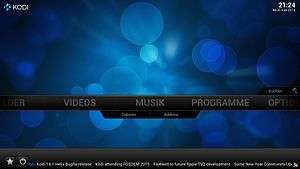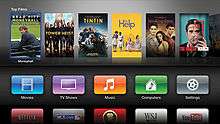10-foot user interface


In computing, a 10-foot user interface ("10-foot UI") is a graphical user interface designed for televisions. Compared to desktop computer and smartphone user interfaces, it uses text and other interface elements which are much larger in order to accommodate a typical television viewing distance of 10 feet (3 meters). Additionally, the limitations of a television's remote control necessitate extra user experience considerations to minimize user effort.[1][2][3]
Design
The term "10-foot" is used to differentiate this user interface style from those used on desktop computers, which typically assume the user's eyes are only about two feet (60 cm) from the display. This difference in distance from the display has a huge impact on the interface design, requiring the use of extra large fonts on a television and allowing relatively few items to be shown on a television at once.[4][5][6]
A 10 foot UI is almost always designed to be operated by a simple hand-held remote control. Rather than the mouse or touchscreen which are commonly used with other types of user interfaces, the remote's directional pad is the primary means of navigation. This means that a 10-foot UI needs to arrange items on screen in a way that clearly shows which item would be next in each of the four directions of the directional pad - usually a grid layout. Also, without a mouse cursor, the currently-selected item must be highlighted in some way.
Ten-foot interfaces may resemble other post-WIMP systems graphically, due to a similar paucity of pixels, but do not assume the use of a touch screen.[7][8]
The goal of 10 foot user interface design is normally to make the user's interaction as simple and efficient as possible, trying to achieve a more laid-back and relaxed user experience with as few button presses as possible while still having an intuitive layout, in terms of accomplishing user goals—what is often called user-centered design. Good user interface design facilitates finishing the task at hand without drawing unnecessary attention to itself. Graphic design may be utilized to support its usability, however the design process must balance technical functionality and visual elements (e.g., mental model) to create a system that is not only operational but also usable and adaptable to changing user needs.[9][10][11]
See also
References
- ↑ The Digital Home: Designing for the Ten-Foot User Interface
- ↑ http://download.intel.com/support/motherboards/desktop/sb/nuci3hometheatersolutionguide_v02.pdf Intel Next Unit of Computing Driving your 10 foot experience
- ↑ 10 foot Style / Graphical User Interface (GUI) for Growl
- ↑ PC Magazine Definition of: 10-foot user interface
- ↑ Style for TV
- ↑ https://developer.nvidia.com/android-tv-developer-guide Android TV Developer Guide (Nvidia)
- ↑ AVerMedia TV Software
- ↑ Building a 10 Foot UI: Dealing With Platform Diversity
- ↑ http://developer.android.com/design/tv/index.html Designing for Android TV
- ↑ http://www.quora.com/Why-is-the-10-foot-home-TV-experience-so-hard-to-get-right Why is the "10 foot" home TV experience so hard to get right?
- ↑ https://developer.android.com/training/tv/index.html Building Apps for TV